Most of the information on this page is courtesy of Joe DeMarco. Note: some of the information on this page was compiled using a technique informally referred to as "counting heads." It is based on the ongoing study of period documents and photographs, as well as surviving Shermans. Due to the limited nature of available reference sources, some of the information presented here must be considered as "educated guesswork."
First of all, you have to
identify the tank as being an M4(75) with small hatches. Please visit
this
page to do so.
Baldwin Locomotive Works
began Sherman production at its plant in Eddystone, Pennsylvania in October
1942. After manufacturing just twelve M4A2s, the company switched over to the
production of M4s. Baldwin made a total of 1233 M4(75)s with "Dry Stowage" from January, 1943 through January,
1944.
Production Order T-3029 : 12 M4A2(75) and 388 M4(75) tanks manufactured (Oct 1942 - May 1943) : Serial number 1905 / USA 3010759 through S/N 2304 / USA 3011158
Production Order T-3291 : 845 M4(75) tanks manufactured (May 1943 - Jan 1944) Serial Number 15435 / USA 3022537 through S/N 16279 / USA 3023381

Production Order T-3029 : 12 M4A2(75) and 388 M4(75) tanks manufactured (Oct 1942 - May 1943) : Serial number 1905 / USA 3010759 through S/N 2304 / USA 3011158
Production Order T-3291 : 845 M4(75) tanks manufactured (May 1943 - Jan 1944) Serial Number 15435 / USA 3022537 through S/N 16279 / USA 3023381


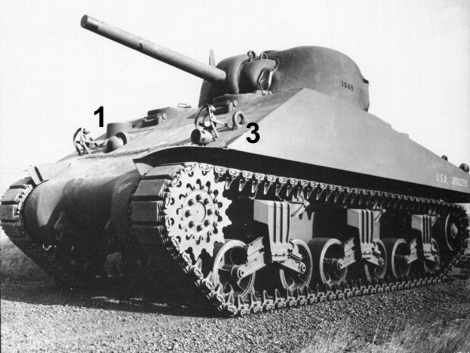
Two photos of Serial Number 1916 (USA 3010770), the last of only 12 M4A2s manufactured by Baldwin. This tank would have been accepted in Nov 1942. Baldwin did not produce any Shermans in December, 1942, most likely because the company was gearing up to transition to production of M4s. SN 1916 can be seen with a cast antenna bracket (1), similar to those observed on some ALCO and Pressed Steel Car M4s. The sharp edges of the bow machine gun socket (2) indicate that it was not cast, but welded together from several pieces of formed armor plate. This type of “fabricated” MG socket was used on the majority of small hatch Fisher Body M4A2(75)s. SN 1916 also has the "bent rod" type of lifting rings (3), typically seen only on very early production Shermans. These were quickly replaced with castings by most Sherman manufacturers.

The above period photo was doctored for a Manual illustration, but shows a fairly typical M4 built by Baldwin Locomotive Works. We have included it so that the reader can see the direct vision visors of the drivers' hoods (all of the known surviving examples have the drivers' hood appliqué plates, which obscure the visors.) This tank was Serial Number 15527 / USA 3022629, indicating it was accepted in June, 1943. Direct vision was found to be a ballistic hazard, and as a result, the Ordnance Department eliminated it from the M4 design in August of 1942. It would take quite a few months before the new drivers' hood castings could be manufactured and procured, but most of the builders made the transition by the end of 1942. In this regard, Baldwin Locomotive has been something of a mystery. The company entered the Sherman program rather late, and produced its first M4A2 in October, 1942, and its first M4 in January, 1943, many months after direct vision was eliminated. For reasons as yet unknown, they appear to have been given an exemption from the design change, and as best we have been able to determine, ALL of Baldwin’s Shermans were manufactured with direct vision.

The above drawing attempts to show the multi-part glacis pattern along with the various components observed on the “typical” Baldwin built M4. (We will comment on some exceptions later on in the piece.) The siren is shown located in what the authors think of as "the second position." Some early Baldwin M4s had it installed in "the first position" on the left front fender, as seen on M4A2 SN 1916 shown earlier.


Although the direct vision slots were considered ballistic weak spots, it seems that Baldwin used them until the end of the production in January 1944. All of the known surviving examples have the drivers' hood "appliqué" armor modification (1). In the two photos above, one can just see the direct vision visors hidden behind the drivers' hood applique plates. These mod kits became available to general Sherman production around August, 1943. At Baldwin it was reported that the introduction occurred on August 16th, at Serial Number 15736. It would be difficult to check that by “counting heads,” since shortly thereafter, the kits were supplied to US Tank Depots for retrofit to Shermans processed for overseas shipment. Furthermore, by late 1943, over 1200 of these kits had been shipped out for installation on the “Group of 1397 Medium Tanks M4 and M4A1 in U.S. Pool in the U.K.” In other words, the drivers’ hood "appliqué" armor, or Blitz Item No. 58 was considered an “Urgent” Modification, to be installed on all of the US Army Shermans intended to take part in the Normandy Campaign. Note also the positive hatch lock mechanisms (2) with equilibrator springs (3), as well as the periscope guards (4); modifications that were introduced in the second half of 1943, and retrofitted to many Shermans that had been built without them.


While most other small hatch Shermans utilized cast components, Baldwin M4s have been observed to have had several fabricated pieces, which had been developed by Fisher Body (see Fisher M4A2 page) as substitutes for castings in response to a shortage of foundry capacity. Above are two views of the fabricated antenna bracket as seen on a surviving Baldwin M4. Note the sharpness of the bracket’s lines, and the distinctive "D" shape.


Above shows two views of the fabricated bow MG socket welded into the tank’s glacis plate. The entire MG socket was a small but elaborate construct that would have required quite a bit of welding, compared to the similar cast piece used by a number of other Sherman builders.



Most
surviving Baldwin M4s are noted to have "fabricated" head lamp
sockets. Above shows a comparison of the "fabricated" versus the cast
part used by most manufacturers. These, as well as the fabricated antenna
brackets and bow MG sockets were on nearly the entire production of small hatch
M4A2(75)s manufactured by Fisher Body. Indeed, the authors would speculate that
Baldwin received its supplies of these fabricated components from Fisher Body. We
would note in passing that the use of cast head lamp sockets was discontinued
with the introduction of the 2nd Generation, 47 degree welded hull Shermans. These
models used simple fabricated D-shaped head lamp sockets.

Here we see Serial Number 16235 on display at the Museu do Comando Militar do Sul in Porto Alegre, Brazil. This unit would have been accepted in late December, 1943, and was one of 53 M4s supplied to Brazil as Lend Lease in 1944. Note that SN 16235 has cast headlamp sockets (1), which would suggest Baldwin may have had more than one supplier for that particular part. Another Baldwin "quirk" has to do with the head lamp plug holders (2). By mid 1943, the other builders had altered the orientation from parallel to the glacis to vertical. Baldwin appears to have continued with the original configuration to the end of production. Baldwin built Shermans are seen with all three types of differential or final drive housings. The 3-piece and original 1-piece housings appear to have been used interchangeably until September, 1943, when the Ordnance Department mandated that all US Sherman production was to incorporate the improved, sharp nosed 1-piece final drive, Part Number E8543. This particular housing can be seen to be the early iteration with the cast in steps (circled). It was found that the steps interfered with the working of the quick release towing shackles that had been introduced with the new final drive. Consequently the cast steps were soon eliminated, and replaced with welded on steps. An Ordnance document has it that the “effective point” at Baldwin for the change over to the E8543 final drive housing occurred on September 30, 1943 at Serial Number 15891. Note the “locking device“ or what has informally come to be known as “the comb” (3). The notches in the metal strip are typical of the combs employed by the Chester Tank Depot in Pennsylvania.

Here we see Serial Number 16235 on display at the Museu do Comando Militar do Sul in Porto Alegre, Brazil. This unit would have been accepted in late December, 1943, and was one of 53 M4s supplied to Brazil as Lend Lease in 1944. Note that SN 16235 has cast headlamp sockets (1), which would suggest Baldwin may have had more than one supplier for that particular part. Another Baldwin "quirk" has to do with the head lamp plug holders (2). By mid 1943, the other builders had altered the orientation from parallel to the glacis to vertical. Baldwin appears to have continued with the original configuration to the end of production. Baldwin built Shermans are seen with all three types of differential or final drive housings. The 3-piece and original 1-piece housings appear to have been used interchangeably until September, 1943, when the Ordnance Department mandated that all US Sherman production was to incorporate the improved, sharp nosed 1-piece final drive, Part Number E8543. This particular housing can be seen to be the early iteration with the cast in steps (circled). It was found that the steps interfered with the working of the quick release towing shackles that had been introduced with the new final drive. Consequently the cast steps were soon eliminated, and replaced with welded on steps. An Ordnance document has it that the “effective point” at Baldwin for the change over to the E8543 final drive housing occurred on September 30, 1943 at Serial Number 15891. Note the “locking device“ or what has informally come to be known as “the comb” (3). The notches in the metal strip are typical of the combs employed by the Chester Tank Depot in Pennsylvania.


The many cast components used on the Sherman are often seen with raised part numbers and foundry logos on them. (Armor plate has the same information stamped into its surface.) Baldwin hulls, like most Sherman hulls, were constructed with cast turret bullet splash guard sections. We’ve circled the raised numbers, letters and symbols on a couple of the splash sections in the photos above. Also of note are the very large raised numbers seen on the ventilator housing in the photo on the left.. This is an unusual feature that was most likely a trait of the particular company that cast them. A number of these have been seen with a “Star-G,” the caster’s logo of the Symington-Gould Company on the deflector piece (inset). While not exclusive to Baldwin M4s, the "big number" ventilators can be seen on many of the surviving examples.

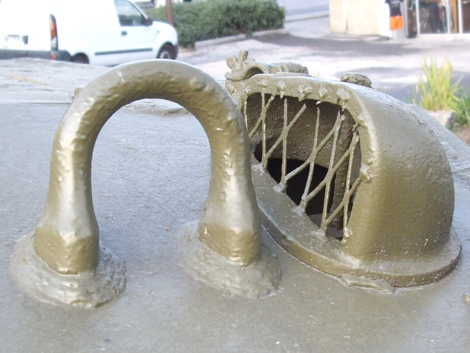
Nearly all of the known surviving Baldwin M4s, and tanks identified as such in period photos, have been seen with the most common type of hull lifting ring castings. We consider these to be the “standard” lifting rings, since they were installed on the vast majority of Shermans produced from January/February 1943 to the end of production. Period photos and two extant examples suggest that early production Baldwin M4s were outfitted with the so called "padded" hull lifting rings, as shown below. Based on the available evidence, the authors speculate that Baldwin transitioned from the "padded" to the “standard” hull lifting rings in February, 1943.

The photo on the left above shows the front "padded" hull lifting rings that appear on two surviving Baldwin M4s, Serial Numbers 1940 and 1948. Both of these would have been accepted in February, 1943, shortly before Baldwin completed the transition to the “standard” hull lifting ring castings shown in the previous caption. The shape of these particular “padded” lifting rings has not as yet been seen by the authors on other types of Shermans, so may have been utilized for a short time only by Baldwin. Note that SN 1940 features the most common version of the rear "padded" hull lifting ring casting (center photo), whereas the rings on SN 1948 are the only ones we have encountered with the shape as seen in the right side photo.
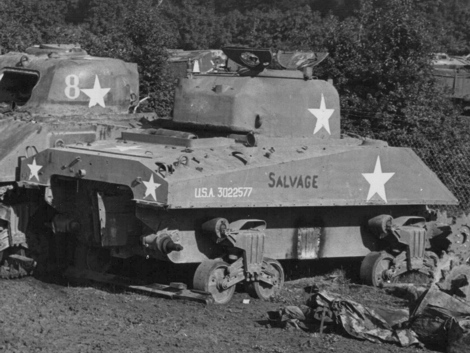
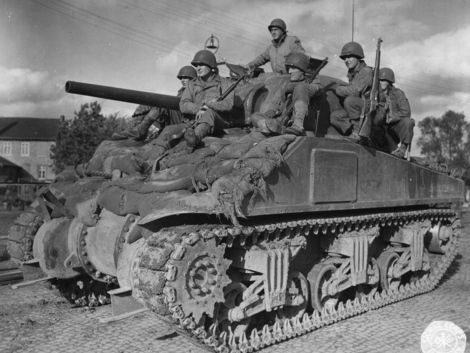
Period photos show Baldwin M4s with either pressed metal spoke (as on USA 3022577 above) or welded spoke bogie wheels. The tanks can also be seen with the most common type of sprocket. For want of a better term, the authors refer too this as "the plain sprocket."


Most
or all of the other builders' M4 and M4A1 Shermans had engine access
door hinges (1) as seen in the above left photo. Oddly, most but not
all, surviving Baldwin built M4s have been noted to have the M3
Lee/Grant type of hinges (2) as seen in the photo on the right. We
suspect these may have been leftover parts from when Baldwin was
directed to change from production of Radial to Diesel powered M3
Mediums. Also,
unlike other manufacturers' M4s and M4A1s, we would observe that the
little stops (3) on either side of the engine access doors are not seen
centered on the few surviving Baldwin M4s but are mounted a little
towards the bottom. The photos also show the rounded transition piece
(4) that joined the lower rear hull plate to the belly plate. This
appears to have been typical of Baldwin M4 lower hull tubs.
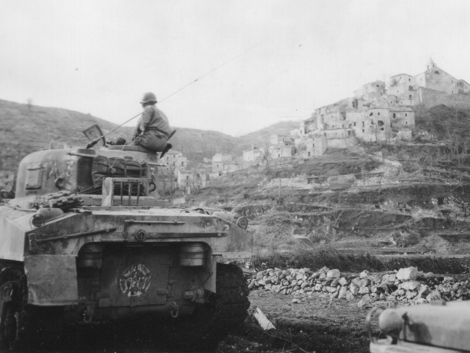
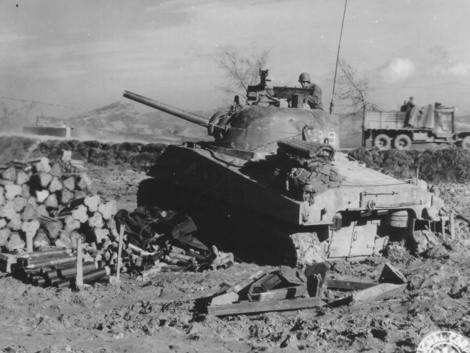
Occasionally, modelers ask if it is possible to determine the appearance of the front of a Sherman if all one has as reference is a photo of the rear. In the case of the two 755th Tank Battalion M4s shown above, and based on the M3 style hinges that can be seen, we would suggest that these tanks would have had the unmodified Baldwin glacis pattern. The round air cleaners seen on both of these Shermans, appear on most, but not all surviving Baldwin M4s.


The only other builder thought to have made M4s with direct vision was Pressed Steel Car. Coincidentally, both Baldwin and PSC M4s have vertical upper rear hull plates, as opposed to the angled plates featured on ALCO, Pullman and Chrysler M4s. The above photos show an M4 used at Aberdeen Proving Ground in November 1943 as a test platform for the T34 Multiple Rocket Launcher. One can see the vertical upper rear hull plate along with the rounded appearance of the lower rear hull plate as it joins to the belly plate. This tank can be seen to be Serial Number 15747 / USA 3022849, indicating August 1943 acceptance. It has most of the modifications that were available at that time. These were mandated to be installed at the factory as the various modification kits entered the production pipeline, and provided the builder was able to obtain sufficient supplies of them. As a backup, Tank Depots were required to install any missing modifications to Shermans headed overseas. This particular M4 can be seen to have a "no pistol port" turret. These were just entering the production lines in August, and it is thought that Baldwin would have finished out their M4 program with this type of turret.

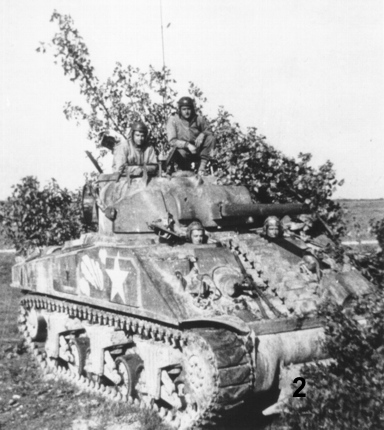
Perhaps the most distinguished user of a Baldwin M4
was Lt. Col. Creighton Abrams, the commander of the 37th Tank Battalion,
4th Armored Division at the time of the Normandy breakout. Above are
two views of his M4, "Thunderbolt V." The left side photo shows the tank
before D-Day. As with nearly every US Army M4 or M4A1 in the UK,
Abrams' tank can be seen to have a good number of modifications. These
changes were considered so essential that thousands of mod kits were
shipped to Great Britain in order to bring the tanks up to late 1943
standards. One of the modifications that appears on the many of the US
Army Shermans in Normandy is “Increase thickness of Turret Armor in
Region of Traversing Gear,” or informally, “the thin spot turret patch" (1). Two
sections of the right front interior of the Sherman’s turret were
thinned out to permit the proper operation of the traversing mechanism.
Early on it was reported that the enemy aimed for these thin spots, and
as a consequence, the Ordnance Dept. produced an armor patch to protect
this area. The right side photo shows "Thunderbolt V" in France in
August, 1944. Just visible in the photo is a hedgerow cutter (2), a
modification developed in theater to enable tanks to break through the
hedgerows typical of the bocage country of Normandy. For some reason,
sand shields were considered an "Urgent" modification. Comparing the
photos of Thunderbolt V, gives an idea of the prevailing view of the
tankers toward sand shields.


The photo above was taken in Vannes, France on
August 5, 1944, and provides a left side view of Thunderbolt V.
Unfortunately, motion blur prevents us from getting an accurate read of
the USA Number, but it can be seen to be in the 3022XXX range,
indicating that it was built sometime from May through September, 1943
as part of Baldwin’s second Production Order. Along with the “thin
spots” in the turret, the Ordnance Dept. found the pistol port to be a
ballistic weak point, and in April, 1943 ordered that the turret be
redesigned. The new casting did away with the pistol port, and at the
same time, increased the thickness of the armor around the thin spots,
thereby eliminating the need for the welded on turret patch. The
redesigned turrets began to enter the production pipeline in the late
summer of 1943, but in the meantime, the Government ordered that pistol
ports on the remaining supply of original turrets be welded up. The lack
of hinges indicates that Thunderbolt V had a welded up pistol port.
Counting heads suggests that Baldwin M4s
produced from May through July, 1943 were built with welded up pistol
ports. We would note that the welding up and subsequent elimination of
the pistol port was not popular with tankers, and the Ordnance
Department reinstated it back into the design in July, 1943. The
reinstated turrets, which also introduced a loader’s hatch, began to
appear in production in late 1943.

A Baldwin M4 very similar to "Thunderbolt V” is on display at the War Museum in Overloon, The Netherlands. This tank is Serial Number 15499 (tow lug inset), indicating that it was accepted in May, 1943. This was months before such modifications as the “Quick Fix” (1), “Sloping Armor in front of drivers’ hatches (2),” Commander’s Vane Sight (3) and the 2 inch Smoke Mortar (4) became available to the builders. It is thought that these mods were installed at a US Tank Depot, or more likely, in the UK in the months preceding D-Day. In 1947, the Museum certified to MIA investigators from the American Graves Registration Detachment that no human remains were found in the two M4 Shermans (USA 3022601 and 3033401) that they recovered from the fields around Overloon. We would note that 3022601 is an exact mathematical match to Serial Number 15499. It is almost certain that SN 15499 served with the 7th Armored Division, and is said to have been put out of action in Hattertweg Vierlingsbeek, Netherlands on 4 October, 1944. The Museum might have exposed the name “After Hitler” by “paint archeology,” but it is doubtful that the tactical and other markings now on this tank are authentic reproductions of what was painted on at the time it was recovered. Photo courtesy of the late Massimo Foti, a fine photographer, and friend to Sherman Minutia.

A Baldwin M4 very similar to "Thunderbolt V” is on display at the War Museum in Overloon, The Netherlands. This tank is Serial Number 15499 (tow lug inset), indicating that it was accepted in May, 1943. This was months before such modifications as the “Quick Fix” (1), “Sloping Armor in front of drivers’ hatches (2),” Commander’s Vane Sight (3) and the 2 inch Smoke Mortar (4) became available to the builders. It is thought that these mods were installed at a US Tank Depot, or more likely, in the UK in the months preceding D-Day. In 1947, the Museum certified to MIA investigators from the American Graves Registration Detachment that no human remains were found in the two M4 Shermans (USA 3022601 and 3033401) that they recovered from the fields around Overloon. We would note that 3022601 is an exact mathematical match to Serial Number 15499. It is almost certain that SN 15499 served with the 7th Armored Division, and is said to have been put out of action in Hattertweg Vierlingsbeek, Netherlands on 4 October, 1944. The Museum might have exposed the name “After Hitler” by “paint archeology,” but it is doubtful that the tactical and other markings now on this tank are authentic reproductions of what was painted on at the time it was recovered. Photo courtesy of the late Massimo Foti, a fine photographer, and friend to Sherman Minutia.

Baldwin
Locomotive is reported to have received its supply of turrets from Buckeye
Steel and Union Steel. SN 15499 has a Buckeye turret dated 3-43 (March, 1943)
as shown in the inset. It is thought that Buckeye delivered this turret to
Baldwin with the pistol port welded up, and the “thin spot” patch installed.
Pistol ports are seen welded up in many different ways, but the very neat job
shown here has been observed on a few Buckeye turrets dated 3-43 and 4-43.
Judging by the look of the pistol port, we would guess Thunderbolt V had a
Buckeye turret. Unfortunately for US tankers, the majority of the M4s and M4A1s
used in the Normandy Campaign had either welded up or no pistol port turrets.

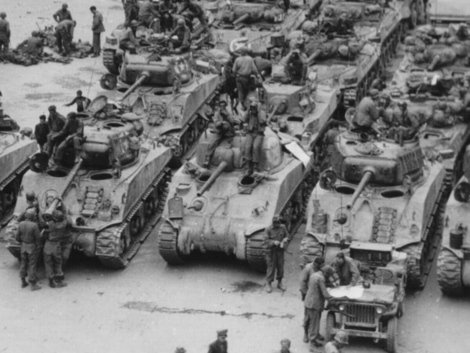
Internal memos state that Baldwin Locomotive transitioned from the M34 to the M34A1 Gun Mount in April 1943. Thus, between 200 and 300 of their first Shermans would have been made with the M34. The M34A1 with telescopic sight was considered an essential modification before D-Day. That is why the reader would be hard pressed to find a photo taken in Northwest Europe of an M4 or M4A1 of any make with the early type gun mount. Not so in the secondary theater of Italy where some Shermans served relatively unmodified right to the end. The photo above left datelined Italy Jan. 5, 1944, shows "Angela Mia," an M4 thought to have served with the 751st Tank Battalion. A close examination of the original print revealed the Registration Number to be USA 3010772, which would correspond to the second Baldwin M4. Note the M34 Gun Mount, vertical upper rear hull plate and the "padded" lifting ring. The image on the right is a blow up of a well known Signal Corps photo that shows a good portion of the 752nd Tank Battalion along with elements of the 805th Tank Destroyer Battalion, gathered in the Plaza Emanuel in Bologna, April 21, 1945. At the time, the 752nd had two companies of M4A3(76)s, but still retained one company of its older M4s and M4A1s. The Sherman in the center with direct vision and the distinctively shaped antenna bracket, certainly suggests a Baldwin M4. This tank appears to be nearly as built, except for the appliqué armor patch on the turret, one of the few modification kits sent to the Mediterranean Theater of Operations in 1943.

The greatest portion of the M4s manufactured in 1943 were sent overseas. Some Baldwin M4s were provided as Lend Lease to the Commonwealth, including a few that were converted to Fireflies. Above is an M4 identified as Serial Number 15970, indicating October 1943 acceptance. The British used this tank in Italy in September 1944 to test Platypus Grousers. Note the late, sharp nosed differential housing introduced at Baldwin in September, 1943. This tank has been outfitted with practically every modification available in the Fall of 1943, including the gun travel lock and periscope guards. Based on internal documents, the authors posit that all of these mods were factory installed from late September until the end of production. While not easily apparent, this tank has a "no pistol port" turret.


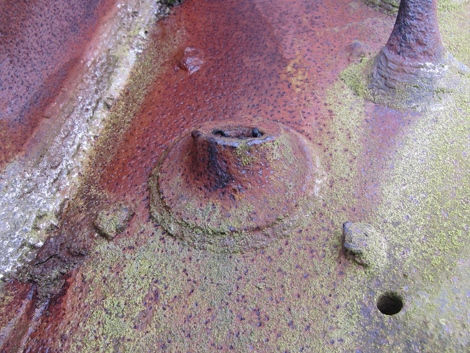

These three photos (courtesy of Michel Van Loon) show an M4 hulk that was photographed on a target range in Brasschaat, Belgium. Despite its condition, it was possible to read the Serial Number as 16276. This was one of the last Shermans built by Baldwin ( the final unit was SN 16279), and was accepted in January 1944. It has the late, sharp nosed E8543 differential housing, but “still” has direct vision blocks, which would tend to confirm that Baldwin Shermans used direct vision hulls right up until the end of production. On the other hand, this was the first Baldwin M4 we encountered that contradicted our original working theory that all them were built with fabricated antenna and bow mg sockets. While this tank does have the typical fabricated bow mg socket, the cast antenna bracket was unexpected. This "new" find raises a number of questions... Did others have the cast bracket? If so, was it limited to a few of the last ones? Or was it random throughout production? Finally, we would observe that SN 16276 also has cast as opposed to fabricated head lamp sockets, such as were noted on the Porto Alegre M4 shown earlier.

In September, 2018 another Baldwin M4 with cast antenna bracket “came to light” in Brazil. This tank is on display at the Centro de Instrução de Blindados in Santa Maria City. The Serial Number found on the original Baldwin dataplate, as well as on the rear tow lugs is 16261, which indicates that it is another of the final 43 units accepted in January, 1944. The cast antenna bracket (inset) appears to be welded on in a manner that is very similar to what can be seen on Pressed Steel Car built M4s. As with SN 16276 from the previous caption, this example features cast head lamp sockets. SN 16261 is “still” in very close to “as built” configuration. The orientation of the head lamp plug holders parallel to the glacis appears to have been typical of Baldwin built M4s right up to the end of production. The E8543 differential housing is the “final” version with the welded on steps (circled). Note the “Chester Tank Depot comb” such as seen on the Porto Alegre M4. SN 16261 was one of 53 M4 Shermans shipped to Brazil as Lend Lease in 1944. Colonel Renato Rocha, commanding officer of the 1º Regimento de Carros de Combate, reported that, “In 1945, my Regiment received all 53 M4s and have used them until 1972 when they where exchanged by M41A3 Walker Bulldog.” Photos courtesy of Col. Renato Rocha.

Not many Shermans have survived with their original dataplates intact. An original dataplate will include the name of the company that produced the tank, whereas the plates on remanufactured Shermans have the name of the firm that rebuilt the tank, or in some instances, nothing at all. Here is a photo of the original Baldwin dataplate from Serial Number 16261. With the exception of Pacific Car & Foundry, the original Sherman dataplates that we have encountered to date only list the year of production in the box at the lower left. Of the 1233 M4s made by Baldwin Locomotive, all but the last 43 were produced in 1943. Note that “1944” is stamped into the box, indicating that it was one of the units accepted in January, 1944, the final month of Sherman production at Baldwin. Considering all of the changes that had been made to the Sherman by the beginning of 1944, it seems odd that Baldwin M4s “still” had direct vision at that late date. The initials “ D N H” can be seen stamped into the box at the lower right. Col. D. N. Hauseman was the Chief of the Philadelphia Ordnance District from August, 1942 through December, 1943, and oversaw operations at the Baldwin Plant. He was replaced by Col. F. A. McMahon in December, but despite that, his initials appear on this January, 1944 production M4. Photo courtesy of Col. Renato Rocha.


Baldwin built Shermans have been noted
to have the tank's Ordnance Serial Number stamped into the rear towing
lugs, shown circled in the photo on the right. In a few instances, the
serial number has been recorded from the front lugs as well. We would
advise those looking for serial numbers to give preference to what is
found on the rear towing lugs, as the differential housing on a
surviving Sherman may not be its original. We have encountered serial
numbers from the front lugs that did not match what was found on the
rear, indicating that the original differential housing had been
replaced.
The authors would gladly receive
such production data information from any readers who encounter a
surviving Baldwin built Sherman.